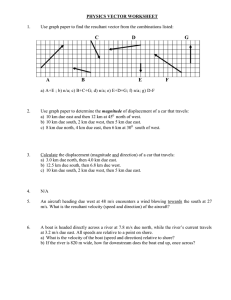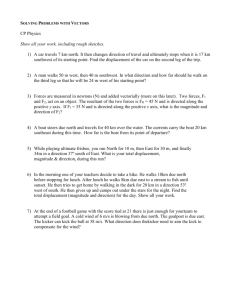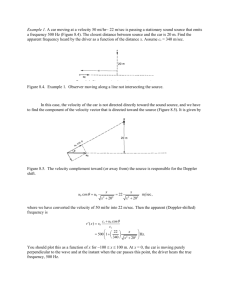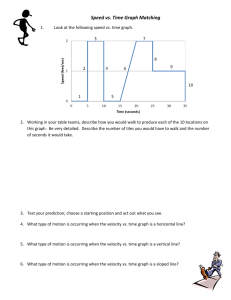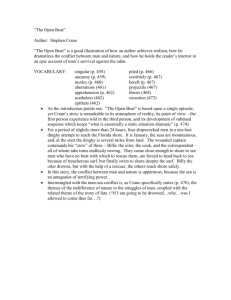Ch3-4
advertisement
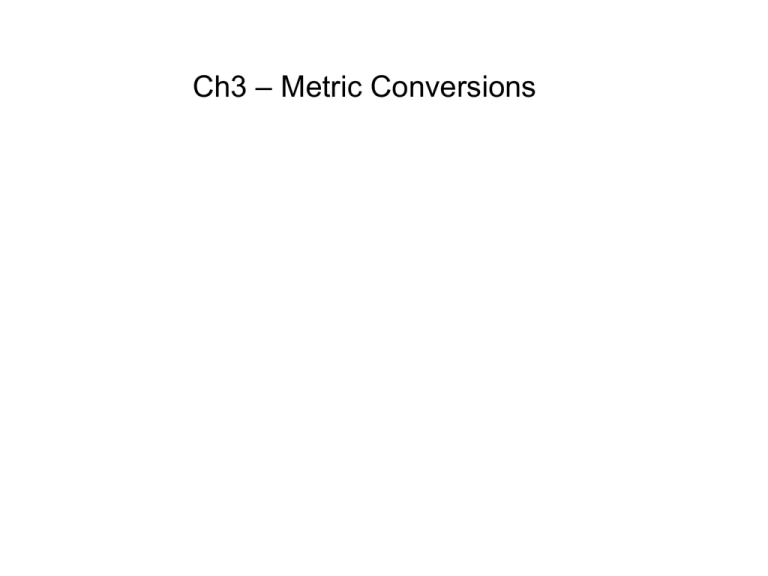
Ch3 – Metric Conversions Ch3 – Metric Conversions “King Henry David Usually drinks chocolate milk” Giga . . Mega . . Kilo Hecta Deka Basic deci centi milli . . micro . . nano . . pico Units “King Henry David Usually drinks chocolate milk” Giga . . Mega . . Kilo Hecta Deka Basic deci centi milli . . micro . . nano . . pico Units (Meters) (Liters) (Grams) G .. M .. K H D U d c m .. μ .. n .. p “King Henry David Usually drinks chocolate milk” Giga . . Mega . . Kilo Hecta Deka Basic deci centi milli . . micro . . nano . . pico Units G .. M .. K H D U d c m .. μ .. n .. p Exs: 505 grams = __________ kilograms 90 cm = __________ m 2.05 L = __________ mL 75 km = __________ m 75 nm = __________ m 700 μm = __________ m Describing Motion Describing Motion Vectors – Scalars – Describing Motion Vectors – describe things that have both magnitude and direction Use arrows to represent them. Scalars – Describing Motion Vectors – describe things that have both magnitude and direction Use arrows to represent them. Scalars – have only magnitude Describing Motion Vectors – describe things that have both magnitude and direction Use arrows to represent them. Scalars – have only magnitude Examples: 1. Speed (v) – vs. 2. Velocity ( v ) – Describing Motion Vectors – describe things that have both magnitude and direction Use arrows to represent them. Scalars – have only magnitude Examples: 1. Speed (v) – how fast something is going vs. 2. Velocity ( v ) – Describing Motion Vectors – describe things that have both magnitude and direction Use arrows to represent them. Scalars – have only magnitude Examples: 1. Speed (v) – how fast something is going vs. 2. Velocity ( v ) – how fast its going in a particular direction Describing Motion Vectors – describe things that have both magnitude and direction Use arrows to represent them. Scalars – have only magnitude Examples: 1. Speed (v) – how fast something is going vs. 2. Velocity ( v ) – how fast its going in a particular direction 1. Distance (d) – vs. 2. Displacement (d ) – Describing Motion Vectors – describe things that have both magnitude and direction Use arrows to represent them. Scalars – have only magnitude Examples: 1. Speed (v) – how fast something is going vs. 2. Velocity ( v ) – how fast its going in a particular direction 1. Distance (d) – how far something moves vs. 2. Displacement (d ) – Describing Motion Vectors – describe things that have both magnitude and direction Use arrows to represent them. Scalars – have only magnitude Examples: 1. Speed (v) – how fast something is going vs. 2. Velocity ( v ) – how fast its going in a particular direction 1. Distance (d) – how far something moves vs. 2. Displacement (d ) – how far something moves in a particular direction. (Straight line distance) Displacement = velocity . time d=v.t Displacement = velocity . time d=v.t Measure velocity in: miles per hour (mph) Kilometers per hour (km/hr) Meters per second (m/s) Displacement = velocity . time d=v.t Measure velocity in: miles per hour (mph) Kilometers per hour (km/hr) Meters per second (m/s) Ex: A car passes a sign that reads 40.1 km while traveling east thru a straight valley. 30 minutes later it passes a sign that reads 84.5 km. How fast was the car traveling? (Use m/s) Ch3 HW#1 1-3 + metric conversions Ch3 HW#1 1. A desert tortoise covers 1.5 m in 45 sec. What is its speed? 2. A bicyclist travels 55 km in 1 hr 30 mins. Speed? 3. Car passes sign that reads 25.6 km traveling north. 1 hr 15 min later it passes a sign that reads 115.2 km. Speed? Metric Conv 1. 7 mm = _____ cm 2. 8.1 mm = _____ m 3. 8.2 mm = _____ km 4. 7.5 cm = _____ mm 5. 6. 7. 8. 6.3 cm = _____ m 9. 7.2 μ = _____ cm 3.3 cm = _____ km 10. 1.2 km = _____ nm 3.6 m = _____ km 11. 1.7 km = _____ cm 5.2 pm = _____ mm Ch3 HW#1 1. A desert tortoise covers 1.5 m in 45 sec. What is its speed? (d=vt) d 1.5m v t 45 sec 0.073m / s 2. A bicyclist travels 55 km in 1 hr 30 mins. Speed? 55 km = 55,000 m 1.5 hr 3600 sec = 5400 sec 1 hr 3. Car passes sign that reads 25.6 km traveling north. 1 hr 15 min later it passes a sign that reads 115.2 km. Speed? d = 115.2 – 25.6 = 89.6 km = 89,600 m 1.25 hr 3600 sec = 4500 sec 1 hr Ch3 HW#1 1. A desert tortoise covers 1.5 m in 45 sec. What is its speed? (d=vt) d 1.5m v t 45 sec 0.073m / s 2. A bicyclist travels 55 km in 1 hr 30 mins. Speed? 55 km = 55,000 m d 55,000m v 10.2m / s 1.5 hr 3600 sec = 5400 sec t 5400 sec 1 hr 3. Car passes sign that reads 25.6 km traveling north. 1 hr 15 min later it passes a sign that reads 115.2 km. Speed? d = 115.2 – 25.6 = 89.6 km = 89,600 m 1.25 hr 3600 sec = 4500 sec 1 hr Ch3 HW#1 1. A desert tortoise covers 1.5 m in 45 sec. What is its speed? (d=vt) d 1.5m v t 45 sec 0.073m / s 2. A bicyclist travels 55 km in 1 hr 30 mins. Speed? 55 km = 55,000 m d 55,000m v 10.2m / s 1.5 hr 3600 sec = 5400 sec t 5400 sec 1 hr 3. Car passes sign that reads 25.6 km traveling north. 1 hr 15 min later it passes a sign that reads 115.2 km. Speed? d = 115.2 – 25.6 = 89.6 km = 89,600 m 1.25 hr 3600 sec = 4500 sec 1 hr d 89,600m v 19.9m / s t 4500 sec Ch3 HW#1 Metric Conv G . . M . . KHDUdcm . . μ . . n . . p 1. 7 mm = ____ cm 2. 8.1 mm = ______ m 3. 8.2 mm = ________ km 4. 7.5 cm = ___mm 5. 6. 7. 8. 6.3 cm = _______ m 3.3 cm = ________ km 3.6 m = _______km 5.2 pm = ____________mm 9. 7.2 μm = _______ cm 10. 1.2 km = ______________nm 11. 1.7 km = ______ cm Ch3 HW#1 Metric Conv G . . M . . KHDUdcm . . μ . . n . . p 1. 7 mm = 0.07 cm 2. 8.1 mm = 0.0081 m 3. 8.2 mm = 0.0000082 km 4. 7.5 cm = 75 mm 5. 6. 7. 8. 6.3 cm = _______ m 3.3 cm = ________ km 3.6 m = _______km 5.2 pm = ____________mm 9. 7.2 μm = _______ cm 10. 1.2 km = ______________nm 11. 1.7 km = ______ cm Ch3 HW#1 Metric Conv G . . M . . KHDUdcm . . μ . . n . . p 1. 7 mm = 0.07 cm 2. 8.1 mm = 0.0081 m 3. 8.2 mm = 0.0000082 km 4. 7.5 cm = 75 mm 5. 6. 7. 8. 6.3 cm = 0.063 m 3.3 cm = 0.000033 km 3.6 m = 0.0036 km 5.2 pm = 0.000 000 0052 mm 9. 7.2 μm = _______ cm 10. 1.2 km = ______________nm 11. 1.7 km = ______ cm Ch3 HW#1 Metric Conv G . . M . . KHDUdcm . . μ . . n . . p 1. 7 mm = 0.07 cm 2. 8.1 mm = 0.0081 m 3. 8.2 mm = 0.0000082 km 4. 7.5 cm = 75 mm 5. 6. 7. 8. 6.3 cm = 0.063 m 3.3 cm = 0.000033 km 3.6 m = 0.0036 km 5.2 pm = 0.000 000 0052 mm 9. 7.2 μm = 0.00072 cm 10. 1.2 km = 12,000,000,000,000 nm 11. 1.7 km = 170,000 cm Ch3.3 Velocity and Acceleration Velocity – speed in a specific direction Ch3.3 Velocity and Acceleration Velocity – speed in a specific direction Average velocity – since speed can vary in most cases, use average speed. - easiest method is finding total distance divided by total time Ch3.3 Velocity and Acceleration Velocity – speed in a specific direction Average velocity – since speed can vary in most cases, use average speed. - easiest method is finding total distance divided by total time d v t Ch3.3 Velocity and Acceleration Velocity – speed in a specific direction Average velocity – since speed can vary in most cases, use average speed. - easiest method is finding total distance divided by total time d v t Instantaneous velocity – speed and direction at that moment (GPS and speedometer in your car) Ch3.3 Velocity and Acceleration Velocity – speed in a specific direction Average velocity – since speed can vary in most cases, use average speed. - easiest method is finding total distance divided by total time d v t Instantaneous velocity – speed and direction at that moment (GPS and speedometer in your car) Ex1) Standing on a roof 100m above the ground, a kid drops a water balloon 4.5s it hits the ground. What was the average speed? Ex2) Hair grows at an average rate of 3x10-9 m/s. Find the length after one year. Ex2) Hair grows at an average rate of 3x10-9 m/s. Find the length after one year. d = v.t = (3x10-9m/s)(3.2x107s) = 0.09m (9 cm) What if the hair was already 10cm long before the year started, how long would it be a year later? To find distance when not starting at zero: df = di + v.t Ex3) A car passes a sign that reads 213.8km. If the cruise control is set at 88km/hr, what does a sign read ½ hour later? Acceleration – a measure of the change in velocity v a t speeding up: a = (+) slowing down: a = (–) Ex4) Set up only: A driver traveling at 25m/s slows at a constant rate of 8.5m/s2. What is the total distance the car moves before stopping? Ch3 HW#2 4 – 8 Lab3.1 – Motion - due tomorrow - go over Ch3 HW#2 @ beginning of period Ch3 HW#2 4 – 8 (Set up, no solve, except 8) 4. A dragster starting from rest accelerates at 49 m/s2. How fast is it going when it has traveled 325m? 5. The same dragster reaches the end of the drag strip rolling at 100km/hr, when it opens its parachute. It rolls to a stop in 150m. How much time does it take to come to a stop? 6. A ball is thrown upward at 25m/s. Gravity slows it at 10m/s2. What height does it reach? 7. A ball is hit and then slowly comes to a stop in 5 sec. Draw. When is it going fastest? What is its final speed? Is its accl +/-? 8. Solve: Enter a toll road at 1pm. After traveling 55km, the ticket is stamped 2:30pm. What was the average speed. At any time could it have been going faster than the average? Why speed not velocity? Ch 4 - Vectors -Have magnitude (length) and point in a direction Ch 4 - Vectors -Have magnitude (length) and point in a direction Ex1) Draw vectors representing velocities: 15 m/s North 10 m/s East Vectors can be added together, called vector addition Vectors can be added together, called vector addition - Graphically, place them head to tail Vectors can be added together, called vector addition - Graphically, place them head to tail - Mathematically, vector addition means 3 possibilities: Vectors can be added together, called vector addition - Graphically, place them head to tail - Mathematically, vector addition means 3 possibilities: 1. Point same direction: Add 2. Point opposite directions: Subtract 3. Point perpendicular: Pythag Ex2) Vector Addition: a) 2 km east and 1 km east b) 3 km east and 2 km west c) 3 km north and 4 km east Ex2) Vector Addition: a) 2 km east and 1 km east 2km (Red is the resultant vector) 1km 2 + 1 = 3 km 3km b) 3 km east and 2 km west 1km 2km 3–2=1 (Red is the resultant vector) 4km c) 3 km north and 4 km east 32 42 5km 3km 5 km (Red is the resultant vector) --The order you add vectors doesn’t matter HW#2) A shopper walks from the door of the mall to her car 250 m down a lane of cars, then turns 90° to the right and walks an additional 60 m. What is the magnitude of the displacement of her car from the mall door? HW#2) A shopper walks from the door of the mall to her car 250 m down a lane of cars, then turns 90° to the right and walks an additional 60 m. What is the magnitude of the displacement of her car from the mall door? 60 250 Mall d = √ 250 +60 = 257m 2 2 3. A boat is rowed South at 3 m/s down a river that flows South at 5 m/s. What speed does an observer from shore see the boat moving? -A boat is rowed North at 3 m/s up a river that flows South at 5 m/s. What speed does an observer from shore see the boat moving? -A boat is rowed East at 3 m/s across a river that flows South at 5 m/s. What speed does an observer from shore see the boat moving? 3. A boat is rowed South at 3 m/s down a river that flows South at 5 m/s. What speed does an observer from shore see the boat moving? 3m/s 5m/a 8m/s -A boat is rowed North at 3 m/s up a river that flows South at 5 m/s. What speed does an observer from shore see the boat moving? -A boat is rowed East at 3 m/s across a river that flows South at 5 m/s. What speed does an observer from shore see the boat moving? 3. A boat is rowed South at 3 m/s down a river that flows South at 5 m/s. What speed does an observer from shore see the boat moving? 3m/s 8m/s 5m/a -A boat is rowed North at 3 m/s up a river that flows South at 5 m/s. What speed does an observer from shore see the boat moving? 3 5 2m/s -A boat is rowed East at 3 m/s across a river that flows South at 5 m/s. What speed does an observer from shore see the boat moving? 3. A boat is rowed South at 3 m/s down a river that flows South at 5 m/s. What speed does an observer from shore see the boat moving? 3m/s 8m/s 5m/a -A boat is rowed North at 3 m/s up a river that flows South at 5 m/s. What speed does an observer from shore see the boat moving? 3 5 2m/s -A boat is rowed East at 3 m/s across a river that flows South at 5 m/s. What speed does an observer from shore see the boat moving? v = √ 32 +52 3 5 v = 5.8m/s Θ HW#8. An airplane flies due north at 150 km/h with respect to the air. There is a wind blowing at 75 km/h to the east relative to the ground. What is the plane’s speed with respect to the ground? Ch4 HW#1 1 – 8 HW#8. An airplane flies due north at 150 km/h with respect to the air. There is a wind blowing at 75 km/h to the east relative to the ground. What is the plane’s speed with respect to the ground? 75 km/hr 150 km/hr v = √ 1502 + 752 = 167.7 km/hr Ch4 HW#1 1 – 8 Lab3.2 More Motion - due tomorrow (in school terms) - Ch4 HW#1 due at the beginning of the period Ch4 HW #1 1 – 8 1. A car is driven 125 km due west, then 65km due south. What is the magnitude of its displacement? 2. (In class) Ch4 HW #1 1 – 8 1. A car is driven 125 km due west, then 65km due south. What is the magnitude of its displacement? 125 km 65 km 2. (In class) d = √1252 + 652 = 141 km 3. In class 4. A car moving east at 45 km/hr for 1 hour turns and travels north at 30 km/hr for 2 hours. What are the magnitude of its displacement? 5. You are riding in a bus moving slowly through heavy traffic at 2.0 m/s. You hurry to the front of the bus at 4.0 m/s relative to the bus. What is your speed relative to the street? 3. In class 4. A car moving east at 45 km/hr for 1 hour turns and travels north at 30 km/hr for 2 hours. What are the magnitude of its displacement? d=v∙t = (30km/hr)(2hr) = 60km 60 km d = √452 + 602 45 km 5. You are riding in a bus moving slowly through heavy traffic at 2.0 m/s. You hurry to the front of the bus at 4.0 m/s relative to the bus. What is your speed relative to the street? 2 4 d=2+4 = 6 m/s 6. A motorboat heads due east at 11 m/s relative to the water across a river that flows due north at 5.0 m/s. What is the velocity of the motorboat with respect to the shore? 5m/s 11m/s 7. A person walks 3 blocks north, turns and walks 2 blocks east, turns and walks 4 more blocks north, and finally turns east and walks 2 more blocks east. In terms of city blocks, how far is the person from where they started? (Hint: vectors can be added in any order. Maybe you can switch the order so that they make a triangle to pythag.) 8. In class 6. A motorboat heads due east at 11 m/s relative to the water across a river that flows due north at 5.0 m/s. What is the velocity of the motorboat with respect to the shore? 5m/s 11m/s 7. A person walks 3 blocks north, turns and walks 2 blocks east, turns and walks 4 more blocks north, and finally turns east and walks 2 more blocks east. In terms of city blocks, how far is the person from where they started? (Hint: vectors can be added in any order. Maybe you can switch the order so that they make a triangle to pythag.) 4 blocks E 7 block N 8. In class Trigonometry & Vector Components S O H C A H T O A Trigonometry & Vector Components S in O pp H yp C os A dj H yp T an O pp A dj Trigonometry & Vector Components S in O pp H yp C os A dj H yp T an O pp A dj opp sinΘ = hyp adj cosΘ = hyp opp tanΘ = adj Trigonometry & Vector Components S in O pp H yp C os A dj H yp T an O pp A dj opposite opp sinΘ = hyp adj cosΘ = hyp opp tanΘ = adj Θ adjacent A Θ cosΘ = adj hyp sinΘ = opp hyp tanΘ = opp adj cosΘ = Ax A sinΘ = Ay A tanΘ = Ay Ax Ax = A∙ cosΘ Ay = A∙ sinΘ Θ = tan-1 ( Ay Ax ) A Ay Ay Θ Ax Ax2 + Ay2 = A2 cosΘ = adj hyp sinΘ = opp hyp tanΘ = opp adj cosΘ = Ax A sinΘ = Ay A tanΘ = Ay Ax Ax = A∙ cosΘ Ay = A∙ sinΘ Θ = tan-1 ( Ay Ax ) Ex 1) A bus travels 23 km on a straight road that is 30° north of east. What are the north and east components if its displacement? Ex 2) A boat travels with a speed of 20 m/s due east. The current moves at 5 m/s due south. What is the speed if the boat w.r.t. the shore, and what angle does it head? Ex 1) A bus travels 23 km on a straight road that is 30° north if east. What are the north and east components if its displacement? dx = d ∙ cosΘ = (23km) ∙ cos30° =19.9km dy 30° dx dy dy = d ∙ sinΘ = (23km) ∙ sin30° =11.5km Ex 2) A boat travels with a speed of 20 m/s due east. The current moves at 5 m/s due south. What is the speed if the boat w.r.t. the shore, and what angle does it head? Ex 1) A bus travels 23 km on a straight road that is 300 north if east. What are the north and east components if its displacement? dx = d ∙ cosΘ = (23km) ∙ cos30° =19.9km dy dy 30° dy = d ∙ sinΘ = (23km) ∙ sin30° =11.5km dx Ex 2) A boat travels with a speed of 20 m/s due east. The current moves at 5 m/s due south. What is the speed if the boat w.r.t. the shore, and what angle does it head? 20 m/s Θ v =? v2 = 202 + 52 5 m/s = 20.6 m/s 5 Θ = tan-1( 20 ) = 14° HW #9. What are the components of a vector of magnitude 1.5 m at an angle of 35° from the positive x-axis? HW #9. What are the components of a vector of magnitude 1.5 m at an angle of 35° from the positive x-axis? dx = d ∙ cosΘ = 1.5m ∙ cos350 = 1.2m dy dy dx dy = d ∙ sinΘ = 1.5m ∙ sin350 = .86m Ch 4 HW #2 9-15 For lab 4.1: - due tomorrow - Ch4 HW#2 due at beginning of period dy Θ } dx Ch4 HW#2 9 – 15 10. A hiker walks 14.7 km at an angle 35° south of east. Find the east and north components of this walk. 11. An airplane flies at 65 m/s in the direction 149° counterclockwise from east. What are the east and south components of the plane’s velocity? Ch4 HW#2 9 – 15 10. A hiker walks 14.7 km at an angle 35° south of east. Find the east and north components of this walk. dx = d ∙ cosΘ = (14.7km) ∙ cos35° = dx dy 35° dy = d ∙ sinΘ = (14.7km) ∙ sin35° = dy 11. An airplane flies at 65 m/s in the direction 149° counterclockwise from east. What are the east and south components of the plane’s velocity? vx = v ∙ cosΘ = (65m/s) ∙ cos149° = 149° vx vy vy = v ∙ sinΘ = (65m/s) ∙ sin149° = 12. A golf ball, hit from the tee, travels 325 m in a direction 25° south of east. What are the east and north components of its displacement? 13. An airplane flies due south at 175 km/h with respect to the air. Wind blowing at 85 km/hr to the east wrt the ground. Plane’s speed wrt the ground? 12. A golf ball, hit from the tee, travels 325 m in a direction 25° south of east. What are the east and north components of its displacement? dx = d ∙ cosΘ = (325m) ∙ cos25° = dx 25° dy dy dy = d ∙ sinΘ = (325m) ∙ sin25° = 13. An airplane flies due south at 175 km/h wrt the air. Wind blowing at 85 km/hr to the east wrt the ground. Plane’s speed wrt the ground? v2 = 1752 + 852 Θ v =? 175km/ hr = 194.6 km/hr Θ = tan-1( 85 ) = 26° 175 85km/hr 14. A rowboat is paddled at 5 m/s, with respect to the water, perpendicular to the shore of a river that flows at 4 m/s with respect to the shore. What is the velocity (both magnitude and direction) of the boat wrt the shore? 5 4 Θ 15. An airplane has a speed of 285 km/h with respect to the air. There is a side wind blowing at 65 km/h with respect to Earth. What is the plane’s speed and direction with respect to the ground? 14. A rowboat is paddled at 5 m/s, with respect to the water, perpendicular to the shore of a river that flows at 4 m/s with respect to the shore. What is the velocity (both magnitude and direction) of the boat wrt the shore? v = √ 42 +52 5 4 v = 6.4 m/s Θ Θ = tan-1( 4 5 ) = 38.7° 15. An airplane has a speed of 285 km/h with respect to the air. There is a side wind blowing at 65 km/h with respect to Earth. What is the plane’s speed and direction with respect to the ground? vplane Θ vwind 14. A rowboat is paddled at 5 m/s, with respect to the water, perpendicular to the shore of a river that flows at 4 m/s with respect to the shore. What is the velocity (both magnitude and direction) of the boat wrt the shore? v = √ 42 +52 5 4 v = 6.4 m/s Θ Θ = tan-1( 4 5 ) = 38.7° 15. An airplane has a speed of 285 km/h with respect to the air. There is a side wind blowing at 65 km/h with respect to Earth. What is the plane’s speed and direction with respect to the ground? v = √ 2852 +652 vplane v = 292 km/hr Θ vwind Θ = tan-1( 65 ) = 12.8° 285 Ch3,4 Practice Problems 20. Solve: A jet flies from LA to NY, a distance of 6000km in 5.5hrs. What is its average speed? 21. Solve: A bike travels at a constant speed of 4m/s for 5 sec. How far does it go? 22. Set up a model: A bike accelerates from 0.0m/s to 4.0m/s in 4 sec. What distance does it travel? 23. Set up a model: A student drops a ball from a window 3.5m above the sidewalk. The ball accelerates at 9.8m/s2. How fast is it going right as it hits the sidewalk? 24. Set up: you throw a ball downward from a window at a speed of 2.0m/s. (HW) The ball accelerates at 9.8m/s2. How fast is it going right before it hits the ground 2.5m below? 25. You row your boat perpendicular to shore of a river that flows at 10m/s. Your boat has a velocity of 4m/s wrt the water. What is the velocity of the boat wrt the shore? At what angle does it cross? 26. An airplane is traveling at 700km/hr north wrt the air, into a headwind (HW) blowing at 75km/hr south wrt the ground. What is the plane’s speed wrt the ground? 27. The Mars Lander has a vertical velocity of 5.5m/s towards the surface (HW) of Mars. It also has a horizontal velocity of 3.5m/s due to Martian wind. At what speed and angle does it descend? 28. The space shuttle is rising with an average velocity of 100m/s as it is (HW) being pushed East by upper atmospheric wind of 25m/s. What speed and direction do viewers on ground see? 29. Hiker leaves camp, walks 4km East, then 6 km South, then 3km East, then 5km North, then 10km West, and then 8km North. How far is he directly from camp? Ch3,4 Review Problems 30. Set up model: A car is traveling at 30m/s when the driver sees a chicken crossing the road. He takes 0.8 sec to react, then steps on the brakes and slows to a stop at 7.0m/s2. What is total distance traveled? 31. Solve: A car passes a mileage marker reading 155.5km. It travels 2.5hrs before passing another marker. If the car had an average speed of 88km/hr, what will the sign read? 32. You walk 30m south then 30m east. Find the magnitude and direction of the resulting displacement. 33. A balloon rises at 15m/s, wind is blowing at 6.5m/s West. What is velocity and direction balloon moves wrt the ground? 34. A small plane is coasting to earth at 100mph at 20° below the horizontal. At what rate is it approaching the ground? 35. Find the x and y components of a 20km displacement vector at 60°. (The end) vel (m/s) 100 90 80 70 60 50 40 30 20 10 1 2 3 4 5 6 7 8 9 10 time (sec)
